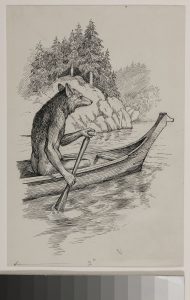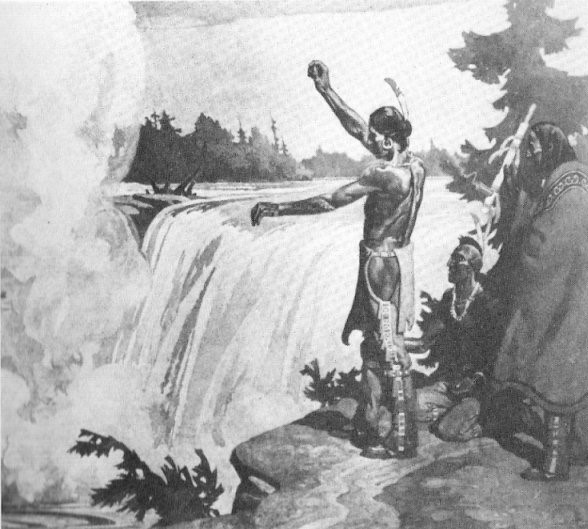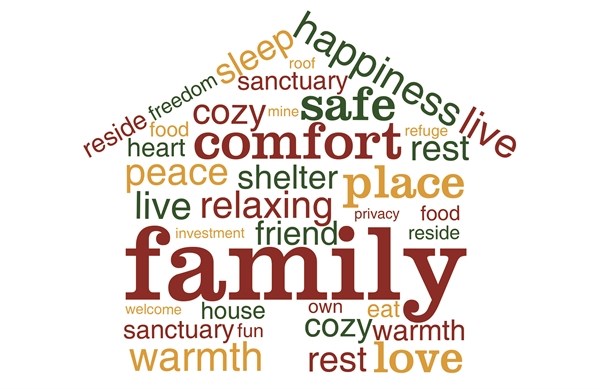For this blog assignment I will reference allusions associated with the characters on pages 29-38 from the 1993 edition of Thomas King’s Green Grass Running Water.
Lone Ranger, Ishmael, Robinson Crusoe and Hawkeye
The names of four First Nation elders, Lone Ranger, Ishmael, Robinson Crusoe and Hawkeye, allude to the famous literary, biblical and television figures of the West.
Flick outlines the allusions of each of these characters in her notes, which can be briefly summarized as follows. Lone Ranger is a hero of Western books, radio, television, movies, which is “[a]t the centre of stories about the Texas Rangers and the lone survivor of a raid. He is a Do Gooder. The Texas Rangers myth has it that one ranger could be sent to clean up a town” (Flick 141). Hawkeye is “a white woodsman and guide with knowledge of “Indian ways” (142), with “adopted “Indian” name. Most famous of the frontier heroes in American literature, when the frontier was in the East— Appalachia, before the frontier “moved” West” (141). Robinson Crusoe is a character based on the true story of Alexander Selkirk, who was deserted on an island but “survives through ingenuity and finds spiritual strength through adversity… King mocks Crusoe’s passion for making lists and for weighing the pros and cons of various situations” (142). Ishmael is a “[c]haracter in Herman Melville’s Moby Dick… when Moby Dick destroys the Pequod, Ishmael survives by staying afloat on Queequeg’s coffin. The name is Biblical: Gen.15.-15” (142).
Despite of the different roles of these characters in their narratives, they all had “their “Indian friend” (71) counterparts” (140). Lone Ranger had his “[f]aithful Indian companion” Tonto. Hawkeye’s best friend is Chingachgook. Robinson Crusoe befriended Friday, a “savage” he saved from cannibals, while Ishmael had a friend Queequeg, who was a cannibal.
Thus, King assigns names to the four elders, which allude to the names of four iconic characters from the Western tales, who in turn managed to befriend and receive loyalty from the “Indian friends”. In other words, the names of the Indigenous storytellers allude to both, Western heroes and their Indigenous counterparts, and the creation stories they tell (from the name of the First Woman, Changing Woman, Thought Woman, and Old Woman) intervene the elements from Western and Indigenous cultures. To add the cycling complexity to the satiric allusions, King places the Indians elders in the land, “[f]rom where they… could see the edges of the world in all directions” (29), in other words in the God-like position, where Ishmael, the only character with biblical name asks: “Are we lost again? Have we made another mistake?” (29). Fluidity and complex portrayal of the four elders and their creation stories are acts of narrative decolonization, as well as an emphasis on the importance of non-binary thinking and diverse worldview.
Dr. Loomis
Next pages of the passage which I analyze include a flashback from Lionel’s point of view on his failed attempt to get a surgery on removal his tonsils.
Flick defines Dr. Loomis as “a private joke” in her notes (146). He was the one who recommended removing Lionel’s tonsils, while Martha Old Crow had diagnosed the boy with a “[s]imple thing” (King 31). She nicknames Dr. Loomis as “the Frog doctor” for his “inordinately long” (31) tongue, typical to frogs. Somebody with a long tongue is also pertinent a person, who talks too much. More to this, the Frog doctor can be interpreted as a “doctor”, who is only capable to dissect frogs, which, in turn, part of the biology classes in the middle and high schools. However, in many traditions around the globe, the frog is symbolic of belonging to water, as well as cleansing, renewal, transformation and metamorphosis attributes. This is why Dr. Loomis recommendation for a surgery is symbolic to Lionel’s renewal and transformation, which I will discuss a little more one paragraph down.
John Wayne
“What would John Wayne do?” said Charlie (King 33). John Wayne is the actor famous for his western movies, including “anti-Indian” roles, like in The Searchers (1956). “Lionel’s childhood desire to be John Wayne and to have his jacket signals his denial of “Indianness” (Flick 147).
So, Lionel, being uncomfortable with his Indigenous heritage, insists on his throat operation, which is, in combination with the Frog doctor’s blessing is symbolic to Lionel’s transformation to the John Wayne-like cowboy, through removal his Indianness (tonsils). The referral for “an easy operation” is arranged by the white doctor, who weekly comes to the reserve even though people prefer to see their own doctors. Doctor Loomis’s regular arrivals to the reserve land remind the colonial settlers, which continued to arrive in hundreds of ships. For Lionel, perspective, what seemed to be as simple as tonsils removal in Calgary, turned into something more serious, which could have been handled in Toronto only (where the Frog Doctor studied), and involved no less than “fixing” his heart.
Thus, new comers take the land (the allusion to the reserve’ visits by the Frog Doctor). Then they take away the Indigenous children and place them into the residential schools to renew and transform their identities (the allusion to sending Lionel away from his mom with the intention to operate his heart and make it work the “right way”).
Transformation story for Lionel was not ended up with his return to Calgary from Toronto. He continued to face the consequences of his attempt to transform in the form of his health records for years. As he admitted, it turned out to be one of three mistakes in Lionel’s life, “the kinds of mistakes that seem small enough at the time, but somehow get out of hand” (30).
Works Cited
Flick, Jane. “Reading Notes for Thomas King’s Green Grass, Running Water.” Canadian Literature161/162 (1999). Web. 12 Mar. 2020.
King, Thomas. Green Grass Running Water. Toronto: Harper Collins, 1993. Print.
King GGRW
Sources
Harris, Elena. “Frog Spirit Animal: Totem Meaning.” Spirit Animal Info, Web. 12 Mar. 2020. https://www.spiritanimal.info/frog-spirit-animal/
“John Wayne.” Biography.com, A&E Networks Television, 27 Apr. 2017, Web. 12 Mar. 2020. https://www.biography.com/actor/john-wayne
O’Dell, Cary. “The Lone Ranger (Episode: “The Osage Bank Robbery”) (December 17, 1937).” The Library of Congress, 2006, Web. 11 Mar. 2020. https://www.loc.gov/static/programs/national-recording-preservation-board/documents/LoneRanger.pdf
Power, Chris. “Best Book of 1947: Call Me Ishmael by Charles Olson.” Granta, 11 Feb. 2020, Web. 12 Mar. 2020. https://granta.com/best-book-of-1947-call-me-ishmael-by-charles-olson/
“QUAINT #3 Hawkeye from The Last of the Mohicans by James Fenimore Cooper.” Beyond Victoriana, 19 Jan. 2011, Web. 11 Mar. 2020. https://beyondvictoriana.com/2011/01/19/quaint-3-hawkeye-from-the-last-of-the-mohicans-by-james-fenimore-cooper/
The Editors of Encyclopaedia Britannica. “Robinson Crusoe.” Encyclopædia Britannica, Encyclopædia Britannica, Inc., 22 Jan. 2019, Web. 12 Mar. 2020. https://www.britannica.com/topic/Robinson-Crusoe-novel







